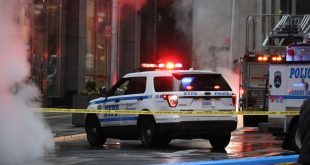Sunny skies, vast beaches and smiling patrons are some of the ideal features of a person’s dream vacation destination. Add a statue of Jesus overlooking the city from the mountain tops and you have arrived in Brazil’s second largest city, Rio de Janeiro.
This coastal town may be the luckiest city in the world because it is soon to host the 2014 World Cup and 2016 Olympic Games, but tragically Rio has been the host nation of murder and social injustice for many years adding definition to the phrase “ethnic cleansing.”
According to the Overseas Security Advisory Council, a subgroup of the U.S Department of State’s Bureau of Diplomatic Security, Rio de Janeiro has been labeled “critical” in its crime rate for the past 25 years. Danger tends to follow any foreign tourists who are visiting the city. Criminals are not afraid to use deadly force to achieve what they want from others.
Imagine the imminent danger for the locals as construction continues to make the World Cup and Olympics a success, problems persist that must be addressed immediately.
As the city gets ready for events in the upcoming years, Rio’s major problems continue to be gangs, corruption, poverty and power.
Nearly all of these dilemmas can be traced to favelas, or slums that surround Rio’s hilltops and are home to millions of residents. There are over 100 favelas and most are ruled by tightly organized drug traffickers and the gangs they employ.
These slums are important because they overcast the rich, upper class coast and downtown areas that will be central to hosting two of the world’s largest international events.
These gangs terrorize the residents in these areas and systematically rob, torture and kill whoever decides to oppose their occupation.
How can you ensure the safety of athletes, when they can see murder and destruction from their hotel windows?
To combat the problems inside the favelas, the local government in Rio has created a special task force to handle the chaos in the poor neighborhoods and “pacify” the violence in preparation for the upcoming events that will have the city in the world’s spotlight.
The Battalion of Special Police Operations has deployed pacification efforts to rid the areas of the drug lords and the terror they spread. Since 2009, BOPE has successfully taken over 20 favelas, plan to overtake 20 more and are looking to have the rest of the favelas pacified before the 2016 Olympics.
In hopes of keeping violence down, BOPE has been active in driving out criminals in the slums who are responsible for numerous arrests.
The team announces which favelas they are coming to beforehand to intimidate drug traffickers, but this gives gangs ample time to pack up their operations and leave or cease the violence for the time being.
Large drug trafficking gangs, such as the Red Command (Rio’s largest and deadliest), have been pacified—but the problem still remains.
While gangs are silenced, BOPE will also support government efforts to get much needed programs and health clinics into the areas that were once impenetrable by police.
According to a TIME Magazine article, one resident described the changes since the favela has been occupied.
“I’ve been here 43 years, and I’ve never seen it as good as it is now,” Eunice Malta, Rio resident, said. “Before it was not life, I would stand here and a gang would come by shooting at everything that moved. Now my kids come and go as they please.”
Sounds like a happy ending to a gruesome tale– but not so fast.
In some areas that have not been reclaimed by BOPE, gangs are becoming stronger by banding together in order to fight back with ferocity toward the special ops group.
Militias, gangs comprised of current and former police, firemen, soldiers and security guards, are taking over where the drug traffickers have left resulting in more deaths of innocent civilians.
Poder Paralelo or “Parallel Power,” is a term used to describe areas that are neglected by the Brazilian government and are outside the protections of the legal justice system. These include areas atop the hills, already reclaimed by BOPE, where lawlessness continues.
In 2002, Tim Lopes, a renowned journalist for his investigative reports in Rio, was brutally beaten ,tortured and was then set on fire, all while alive in one of the areas known for its parallel power in Rio.
Some gangs and militias have bribed corrupt police officers to continue to deal drugs and slaughter mass amounts of people.
Congressman Marcelo Freixo started an effort to end corruption in both law enforcement and government. According to BBC News, his efforts led to the creation of the 2010 film “Tropa de Elite 2,” which identified ex law enforcement officials who are now in militias.
These militias run services such as gas, water and alternative transport in slums, as well as charging protection money and ruling with violence.
Freixo also followed a long money trail connecting a local government official to collusion with criminal organizations which resulted in 225 convictions.
With all of these violent killings and intimidation techniques still occurring, how could the murder rate decrease so rapidly?
A recent HBO documentary offered to share a surprising theory.
In the documentary, “Witness: Rio, “photojournalist Enos Hoagland tries to answer this very question.
Since the murder rate declined, a crime scene investigation task force was enacted to follow up on every homicide in the city and compare their findings to the murder rate that had been reported. Yet before they can make it to crime scenes in the favelas, bodies have disappeared from the crime scene.
The documentary suggests that in order to keep the murder rate down and silenced from the public, police are removing bodies from crime scenes.
So even though the murder rate has sharply declined in the last year, the missing persons rate in Rio has nearly tripled just as fast.
As long as the murder rates are low, the government will not provide answers as to why so many people have gone missing.
Some families are fighting for their right to stay in their homes, but many others have been forced to move to other areas of Rio or to other favelas that are not occupied due to gang violence.
Pushing these people into insecure areas and squalor is not right and can cause more innocent people to be caught in the line of fire.
Christ the Redeemer, a 100 foot tall monument dedicated to Jesus of Nazareth that overlooks the city, can only provide a symbolic gesture of peace to the people of Rio de Janeiro. Everyone else has to do their part to make it happen.
When you think of genocide and ethnic cleansing of disenfranchised communities, many think of Kosovo in the 1990’s, but more recently Joseph Kony and Muammar Gaddafi. t. Let us not add the people of beautiful Rio de Janeiro because of gangs, greed and power.
 The Spectator The independent student newspaper of Valdosta State University
The Spectator The independent student newspaper of Valdosta State University







